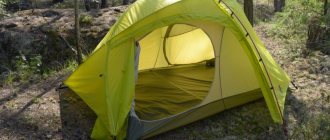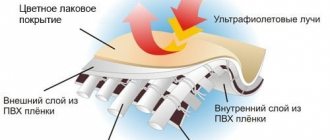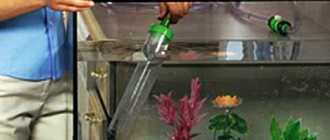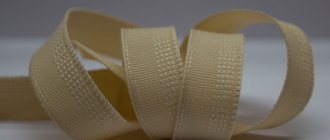Confusion often arises, especially among inexperienced travelers, when assembling and folding a tent. It is important to disassemble it correctly so that the structure is compact, does not take up much space and fits into the case. The figure-eight folding principle is very helpful for compact storage and easy carrying. A video and a detailed diagram will clearly show you how to assemble a tent in a figure eight pattern.
How to assemble a figure eight tent - Diagram
Types of Chinese tents
Products from the Middle Kingdom are in demand all over the world - they are cheaper than analogues from other countries, and sometimes are in no way inferior in quality. This also applies to tents. There are 3 types of them:
- Automatic or semi-automatic. Their advantage is fast, simple installation, taking only a few seconds. You just need to take the mini-tent out of the case. The rods will straighten, the fabric will stretch - everything is ready. They differ in bottom area and number of places.
- Fishermen's. It is an indispensable attribute of winter overnight fishing. They have more durable material, an insulated bottom and additional compartments for gear.
- Tourist tents. Great for camping in any conditions. There can be both automatic machines and stage-by-stage assembly.
Keep in mind that the characteristics of the tent will also depend on its material.
Insulation methods and materials for insulation
The tent must be insulated all around - inside and out. Materials are available and do not require large expenses. Now there are winter versions of tents on the market, but if you already have one, why buy a new one if you can insulate it yourself.
Tips for fisherman: How to properly fish with a reelless reel in winter - Choosing the best
Insulating the top of the tent
The tent is insulated on top to provide additional protection from precipitation and wind. The easiest way is to use plastic film. It should be tight. The tent is covered with material and secured using office clips. From below you need to press down the polyethylene with snow or pieces of ice. Film shelter makes the tent 3-4 times warmer.
The second popular material is the fabric of an old Soviet tent. It is breathable and dense. It’s better to make a cover out of it and put it on top of the dome. Tarpaulin or Oxford protects well from the wind. With such insulation, the tent will not blow out and it will not get wet. Both of these methods increase the thermal insulation properties of the shelter by 4-6 times.
Film cover makes the tent 3-4 times warmer
It is not difficult to insulate using an awning, the main thing is that it covers a single-layer tent by at least 70%. It is preferable to make a cover that simply fits onto the structure.
Internal insulation
Insulating a winter tent from the inside is essential for harsh climates. This prevents condensation from accumulating and turning into ice. You can purchase special material or make a coating to insulate your tent yourself.
The simplest method is to insulate the walls with an old blanket. This option will not be enough for a long time, but for a slight frost, together with external insulation, it is quite enough.
A budget-friendly way is to take padding polyester or batting and staple foil onto it. You need to quilt the material in this way as often as possible so that the foil fits securely to the base. The result is a fabric with heat-reflecting properties. It is fixed to the frame using office clips. The foil layer should be positioned facing the inside of the tent so that the heat from the person and the heater does not escape anywhere.
To achieve maximum insulating effect in winter, it is better to take a ready-made specialized material - Izolon. The minimum thickness is 2mm. It is plastic, durable, and does not rot, which guarantees its reusable use as winter tent insulation. The material is made of foamed polymer with a foil coating. An analogue is Penofol, which also has reflective properties. They have one drawback - the high price.
Isolon - the inner insulation of a tent
Internal insulation of the tent will allow you to retain 6-8 times more heat.
The choice of material depends on the planned time of winter fishing. If it is planned for several days, then you need to buy professional thermal insulation.
Floor insulation
Thermal insulation for the tent floor can be selected from the following materials: camping mats, insulation or thick felt. They are easy to transport in a car when rolled up. The insulation is simply laid in one or several layers. Rugs and isolon are based on foamed polymer, which holds heat well. Felt warms due to wool.
You can insulate the floor with thick felt
It is necessary to take into account that from prolonged use the snow and ice under the heat insulator will melt and a puddle will form. Therefore, the bottom layer needs to be polyethylene.
Despite some windiness and prolonged warming up, this type of shelter is rapidly gaining popularity due to its maximum convenience for the fisherman. The spacious cubic shape with convex walls allows you to stand up to your full height and stretch your legs that are stiff from sitting still. Cubes are more expensive than umbrellas and cones, as they are often equipped with a high-quality frame.
The frame of the structure determines its strength and stability in strong winds. It can be plastic - made of carbon or fiberglass (fiberglass), or metal - aluminum or duralumin. The first is used in inexpensive models. This is a lightweight but short-lived material. Plastic tubes break easily and lose flexibility in the cold. Aluminum models are strong and durable, but are much more expensive than plastic.
Tent awnings are most often made of synthetic polyamides (nylon, nylon) or polyesters (polyester or lavsan). All of them are quite cold and wind resistant. But PE fabrics are less susceptible to stretching when wet and destruction from ultraviolet radiation. In addition, polyester or lavsan shelters weigh less than their nylon counterparts, although they are not affordable.
The strength of the fabric directly depends on the method of weaving the threads in it:
- Taffeta is a classic option for the vast majority of models and is often used for awning walls.
- Oxford is more durable and is used to make artificial flooring.
- Rip Stop - reinforced threads are used here, forming a frame that is resistant to tearing.
On the product label, the fabric density is indicated in tex (175-310T) or den (200-450D). The higher the value you see, the more durable, thicker, but also heavier your tent will be.
Tips for a fisherman: How to fold a tent for winter fishing - What is the difference, pros and cons
Additional moisture resistance is provided by coating with a thin layer of silicone (Si) or polyurethane (PU). For example, the PU5000 indicator indicates that the shelter is capable of holding a 50-centimeter layer of water on the surface.
According to the installation method, all tents can be divided into automatic and manual. The first ones can be quickly and effortlessly disassembled and folded like an umbrella or a spring. The latter require manual assembly of the frame - they are less mobile, but there is no risk that the automatic mechanism will jam at the most inopportune moment.
It is also worth paying attention to the hinges with which the temporary shelter will be attached to the ice. They must be made of durable material with reinforcing gaskets, well stitched, preferably with iron or at least plastic rings inserted inside for reliable fixation on the fasteners. Responsible manufacturers complete their products with special screws (gimlets) for reliable and correct fixation of the tent.
The designs of winter tents are very diverse and the choice of a specific type depends on the preferences of the fisherman or the weather conditions of ice fishing:
The type of folding resembles an umbrella with a regular hexagonal shape of the walls, inclined to the surface at an angle of 45 degrees. Installation of this design takes just a few minutes. The models are distinguished by their low weight, good resistance to strong gusts of wind and quick heating. The downside is that the interior space is very cramped even for one fisherman, although there are two-seater options declared by the manufacturers on sale.
Spring (automatic)
The type of assembly is reminiscent of a children's playhouse, which opens itself when removed from the case. The shape is a cone tapering upward. Among the advantages, it is worth noting simple installation, accessible even to a beginner, light weight and small volume when assembled. The main disadvantage is the lack of rigid ribs, which can lead to deformation of the walls from strong winds.
Trekking (arc)
The frame of the product is made up of intersecting rigid arches to which the awning fabric is attached. These models are the most affordable, have good capacity and lightness. The main inconvenience is fiddling around with the installation, but if you get the hang of it, the whole process will take a matter of minutes.
Despite some windiness and prolonged warming up, this type of shelter is rapidly gaining popularity due to its maximum convenience for the fisherman. The spacious cubic shape with convex walls allows you to stand up to your full height and stretch your legs that are stiff from sitting still. Cubes are more expensive than umbrellas and cones, as they are often equipped with a high-quality frame.
Nowadays, a huge number of ways have been invented to keep warm even in conditions of complete immobility. These are thermal underwear, special shoes and overalls with special impregnation that do not give the slightest chance to cold air, and in case of very severe frosts and bad weather, fishing enthusiasts set up tents for winter fishing, many of which are made with their own hands.
How to fold a Chinese tent into a ring
Automatic tents are made from steel rods and polyester, which gives them an advantage in assembly. In the store, before purchasing, they show you how to properly assemble a Chinese tent. But in field conditions, this process becomes more complicated than it seems. Therefore, it is better to assemble it at home before going into nature, so that there are no problems.
Necessary:
- Place all the edges of the semi-automatic machine together so that it becomes flat.
- Place the resulting figure on a flat surface, pull one of the ends of the tent in your direction.
- Press it to the opposite side, the arcs will twist and be shaped like a figure eight.
- All that remains is to tighten the rods so that they turn into a circle. Then you can put it in a case.
Removing storm guy ropes
To quickly assemble a tent, you need to correctly pull out the storm guy ropes. They are usually located in the corners and serve to pull the awning tightly. As a result, the tent becomes stable, and even strong gusts of wind will not damage its structure.
Typically, storm guy ropes are assembled together with pegs. Since they are thin ropes that can become tangled, it is best to reel in the ropes immediately. This will speed up the re-installation of the structure in the future. To save time, you can simply fold the guy ropes in half and tie them with a simple self-tie knot.
How to assemble a winter tent with a figure eight
Winter model shelters are made from more advanced materials. Mostly synthetic fabric is used - lavsan, polyester, nylon.
To fold a Chinese winter tent, a similar method is used as for an automatic one. The corners are folded diagonally towards the middle. The shape is a square. The diagonal ends are taken in the hands - the upper left corner with the left hand, and the right corner with the right. Next, a circular movement is made - left away from you, right towards you. The tent rolls up into a circle and fits comfortably in the cover.
How to fold a children's tent into a ring
Children should have their own space in which they can spend time alone or with friends. A children's mini-tent has many differences from ordinary camping shelters. This includes the presence of numerous tunnels, the general shape of the structure, and the colors. It may have several exits or additional compartments.
Installing such structures is simple - automatic opening occurs in a few seconds. But some models are quite difficult to assemble. To simplify the work, it is better to know some of the assembly diagrams that the seller provides.
Children's tent "House"
There are only two ways. First:
- Standing opposite any of the walls of a square house, you need to grab the opposite edges of the square.
- It is important to push the rib that is in the right hand to the opposite corner. Folding will cause the mini tent to collapse.
- Position the house so that the roof faces forward and the floor faces you. Hands move towards each other, raising the right hand above the left. The frame, consisting of wire, will curl into a figure eight if the hands are connected.
- Place the resulting small rings one on top of the other. Now the tent can be placed in its cover.
The second method is used if the automatic tent cannot be folded into a figure eight:
- Fold up the walls of the house.
- The “floor” of the house rises upward, holding the side part (wire edge) with your left hand.
- The side wall is pressed against the raised part, which is held in the visual center by the right hand, and folds, as if wrapping around an invisible axis.
- The result is a ring shape, and the resulting second part is pressed against it.
- The circle is ready.
Assembly of components
Many tourists prefer automatic tents, the components of which do not need to be assembled separately. This is really convenient, because in order to unfold the tent, you just need to shake the structure.
But you will have to tinker with assembling such a tent: it needs to be folded perfectly correctly, so that in the future you can easily unfold the shelter by simply shaking it.
If you have a regular tent model, special covers should be provided for the components. They accommodate pegs, arcs, storm guy ropes and the awning itself. It is better to immediately collect all the accessories and place them in separate covers so that nothing gets lost during the process of assembling the tent.
Children's tent "Princess Castle"
To fold such a mini-tent, you need to know that its structure is slightly different from an automatic one. The frame consists of sticks stretched over an elastic band. They support the shape of the house. To assemble it you need:
- Pull out the stick supporting the dome of the tower (it is located in the center) and fold it.
- Take out all the sticks and also arrange them.
- The remaining base and tower fold up. The canvas must be carefully tucked inside.
- If you take the opposite parts of the circle and turn it, you get a figure eight.
- Connect the parts together and secure with an elastic band. Assembly is complete.
Step-by-step production
Despite the fact that this design was born a long time ago, many anglers have tested it in harsh winter conditions.
How to make a tent with your own hands
- Ski poles act as a frame and are installed vertically. Horizontal tubes should be thinner. At the corners, the frame is connected using tees, the diameter of which must match the diameter of both vertical and horizontal tubes.
- The next step is to attach the vertical tubes to the skis. A metal plate is attached to the ski, into which a tongue is inserted in the letter T, attached to the lower end of the tube. To secure the stick, just rotate it at an angle of 90 degrees.
- Two sticks are prepared from an old cot that will connect the frame to the box. Take a bent tube, at the end of which there is a docking unit. At the other end of the tube there is a latch, which serves as a fastening element for the docking unit.
- A spring is made from a copper strip that connects the box to the tubes.
- Finally, all that remains is to pull up the awning. Metal strips with holes are attached to the lower part of the awning. The brackets attached to the ends of the skis are pulled into these holes. The awning is connected to the brackets using ropes. For stable behavior of the tent on ice, it is equipped with two anchors.
The whole essence of such a tent for winter fishing was to fold and unfold as quickly and easily as possible. We all know that the advantage of winter fishing is finding a catchy hole.
How to fix a tent
The main type of failure that can occur during camping conditions is damage to the panel. It is usually made from polyamide and polyester fibers. They are resistant to stretching and tearing, but do not tolerate fire or punctures.
Experienced tourists advise carrying reinforced tape with you; with it you can easily repair any microdamage.
At home, you need to carry out more thorough repairs. You just need to find the right fabric and glue. The best adhesive is Moment Crystal (it is specially designed for working with synthetic materials). Any piece of synthetic fabric will be suitable for the patch.
Before applying the glue, the surface around the puncture is degreased. Next, glue is applied in an even layer and a patch is placed.
After installing the patch, wait 10 minutes at room temperature.











